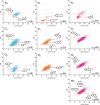Ion Source Complementarity for Characterization of Complex Organic Mixtures Using Fourier Transform Mass Spectrometry: A Review
- PMID: 39400408
- PMCID: PMC12327176
- DOI: 10.1002/mas.21910
Ion Source Complementarity for Characterization of Complex Organic Mixtures Using Fourier Transform Mass Spectrometry: A Review
Abstract
Complex organic mixtures are found in many areas of research, such as energy, environment, health, planetology, and cultural heritage, to name but a few. However, due to their complex chemical composition, which holds an extensive potential of information at the molecular level, their molecular characterization is challenging. In mass spectrometry, the ionization step is the key step, as it determines which species will be detected. This review presents an overview of the main ionization sources employed to characterize these kinds of samples in Fourier transform mass spectrometry (FT-MS), namely electrospray (ESI), atmospheric pressure photoionization (APPI), atmospheric pressure chemical ionization (APCI), atmospheric pressure laser ionization (APLI), and (matrix-assisted) laser desorption ionization ((MA)LDI), and their complementarity in the characterization of complex organic mixtures. First, the ionization techniques are examined in the common direct introduction (DI) usage. Second, these approaches are discussed in the context of coupling chromatographic techniques such as gas chromatography, liquid chromatography, and supercritical fluid chromatography.
Keywords: complex organic mixtures; hyphenation; ionization sources; mass spectrometry; ultrahigh‐resolution.
© 2024 The Author(s). Mass Spectrometry Reviews published by Wiley Periodicals LLC.
Figures











References
-
- Abdul Jameel, A. G. , Khateeb A., Elbaz A., et al. 2019. “Characterization of Deasphalted Heavy Fuel Oil Using Appi (+) FT‐ICR Mass Spectrometry and NMR Spectroscopy.” Fuel 253: 950–963.
-
- Aharoni, A. , Ric de Vos C. H., Verhoeven H. A., et al. 2002. “Nontargeted Metabolome Analysis by Use of Fourier Transform Ion Cyclotron Mass Spectrometry.” OMICS: A Journal of Integrative Biology 6, no. 3: 217–234. - PubMed
-
- Andrade, F. J. , Shelley J. T., Wetzel W. C., et al. 2008. “Atmospheric Pressure Chemical Ionization Source. 1. Ionization of Compounds in the Gas Phase.” Analytical Chemistry 80, no. 8: 2646–2653. - PubMed
-
- Ayala‐Cabrera, J. F. , Lipok C., Moyano E., Schmitz O. J., and Santos F. J.. 2021. “Atmospheric Pressure Ionization for Gas Chromatography‐High Resolution Mass Spectrometry Determination of Polychlorinated Naphthalenes in Marine Sediments.” Chemosphere 263: 127963. - PubMed
Publication types
LinkOut - more resources
Full Text Sources

